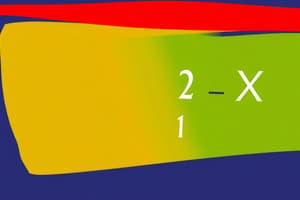Podcast
Questions and Answers
According to the zero exponent rule, what is the value of $10^0$?
According to the zero exponent rule, what is the value of $10^0$?
- 0
- 100
- 1 (correct)
- 10
What is the result of $5^4 \times 5^3$?
What is the result of $5^4 \times 5^3$?
- $5^3$
- $5^{43}$
- $5^{12}$ (correct)
- $5^7$
What does the power rule state?
What does the power rule state?
- The sum of two bases raised to the same power is the product of the bases.
- Any number raised to the power of 1 equals 1.
- Any base raised to the power of zero equals zero.
- Raising an expression to a power involves multiplying the base and exponent. (correct)
Calculate $4^{(-2)}$ using the negative exponent rule.
Calculate $4^{(-2)}$ using the negative exponent rule.
Study Notes
Law of Exponents: Focusing on the Subtopics of Power Rule, Zero Exponent Rule, Negative Exponent Rule, and Product Rule
Introduction
The law of exponents is a set of rules that simplify the process of working with expressions involving powers and exponents. These laws are used to manipulate and simplify expressions by applying specific operations on the base and exponent. In this article, we will discuss the subtopics of power rule, zero exponent rule, negative exponent rule, and product rule in detail.
Power Rule
The power rule is the simplest law of exponents that allows you to exponentiate an expression by multiplying its base and exponent together raised to the same power. Mathematically, it can be expressed as:
a^(mn) = (a^m)^n
For example:
(2^3)^2 = 2^(3*2) = 2^6 = 64
Zero Exponent Rule
The zero exponent rule states that any non-zero base raised to the power of zero is equal to one. Mathematically, it can be expressed as:
a^0 = 1
For example:
7^0 = 1
Negative Exponent Rule
The negative exponent rule involves raising the reciprocal of the base to the absolute value of the exponent. Mathematically, it can be expressed as:
a^(-m) = \frac{1}{a^m}
For example:
(3^(-2)) = \frac{1}{3^2} = \frac{1}{9}
Product Rule
The product rule of exponents states that when multiplying two expressions with the same bases, you can add their powers together and keep the base the same. Mathematically, it can be expressed as:
(a^m)(a^n) = a^(m+n)
For example:
(x^2)(2^3) = x^(1+3) = x^4
In conclusion, the law of exponents provides several rules to simplify expressions involving powers and exponents. These subtopics - power rule, zero exponent rule, negative exponent rule, and product rule - are crucial in understanding and manipulating such expressions. By applying these laws appropriately, one can effectively solve problems involving complex algebraic expressions.
Studying That Suits You
Use AI to generate personalized quizzes and flashcards to suit your learning preferences.
Description
Test your knowledge on the power rule, zero exponent rule, negative exponent rule, and product rule in the law of exponents. This quiz will assess your understanding of how to simplify expressions involving exponents and powers using these fundamental rules.




